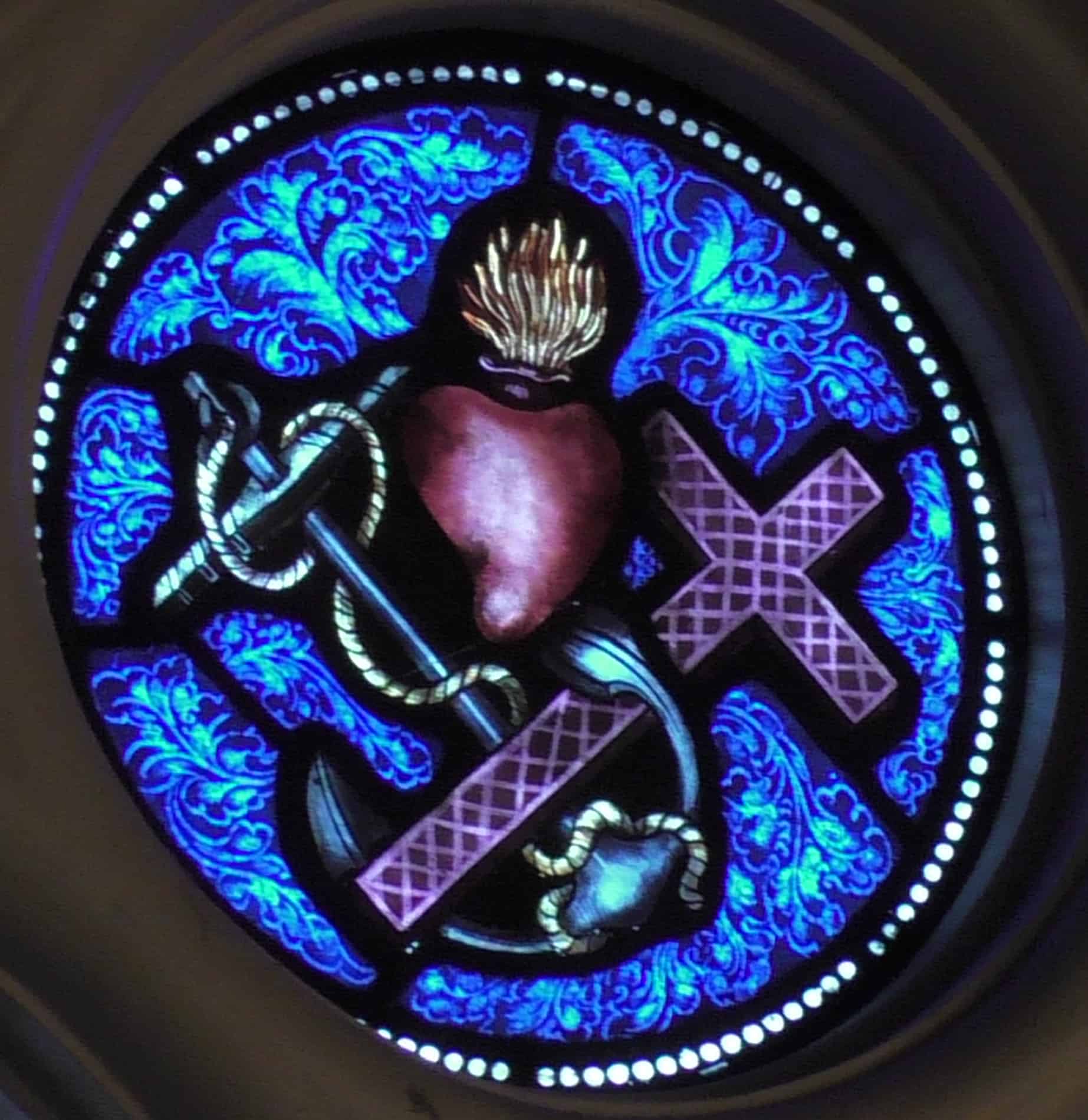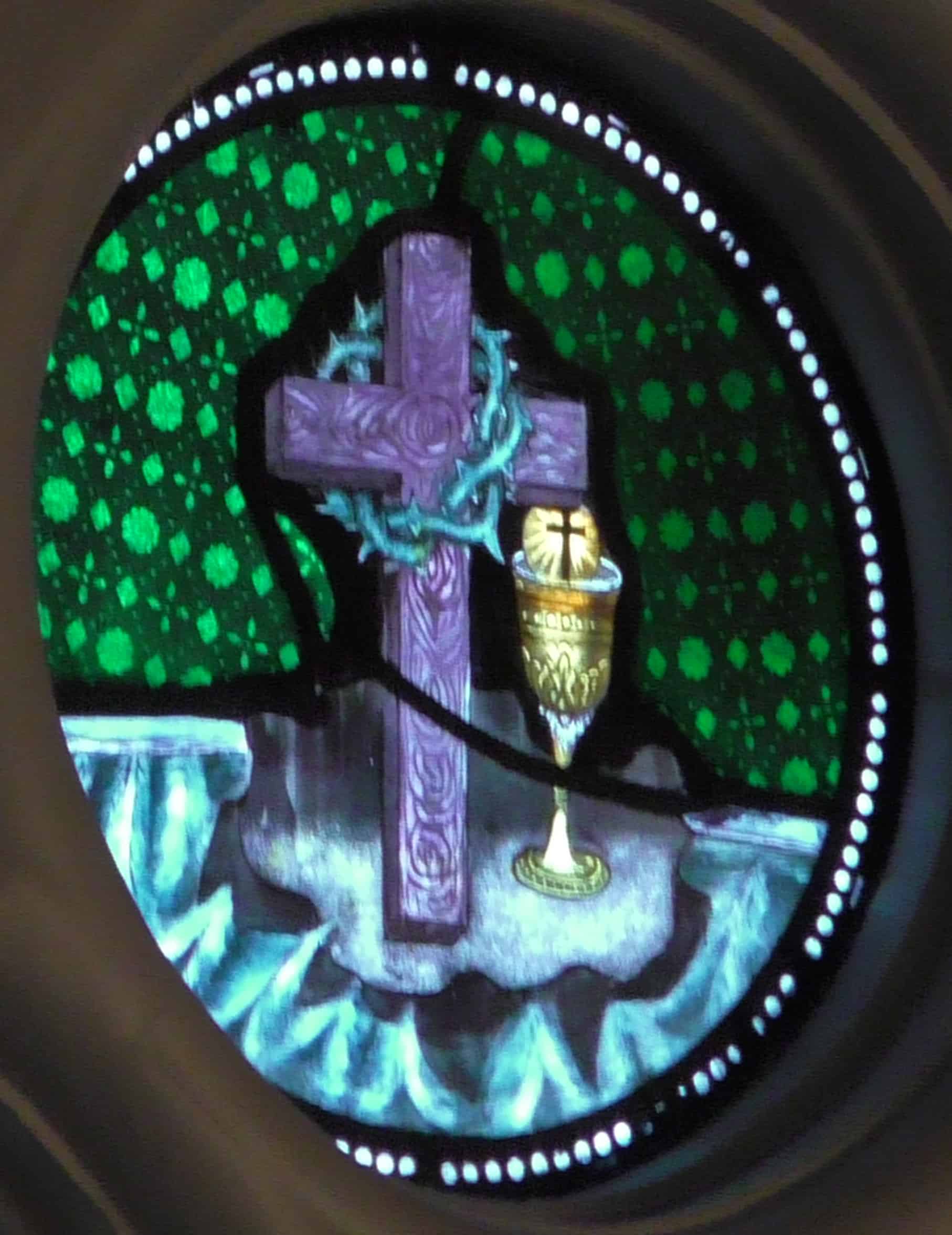 On the left side, as you are looking at the altar there is one of the round windows closer to the choir loft that has a heart with the anchor on one side and a cross on the other side of the heart. The heart is depicted as having a fire coming from the top of it, but it is not the full image of the Sacred Heart of Jesus. The fire depicts God’s love for us in the heart. The anchor on the left side of the heart reminds us of Peter, our first pope, but also the anchor of God’s love for us. It brings peace, comfort and strength in faith when we know how much God was willing to do for us. His love for us is not here today and gone tomorrow. His love is steadfast. It does not depend on how He feels for the day, nor does it go away if we do the wrong thing. His love is an anchor we can depend on in holding us fast so we do not get taken away by the storms of life. Even when we do the wrong thing, He still calls us back and extends His mercy. The anchor wraps its hook around the cross on the right side of the heart. It embraces that cross of mercy for us. The heart, the anchor and the cross are one in Jesus Christ. We really can trust in Him, His mercy and His love. We just might have hope yet.
On the left side, as you are looking at the altar there is one of the round windows closer to the choir loft that has a heart with the anchor on one side and a cross on the other side of the heart. The heart is depicted as having a fire coming from the top of it, but it is not the full image of the Sacred Heart of Jesus. The fire depicts God’s love for us in the heart. The anchor on the left side of the heart reminds us of Peter, our first pope, but also the anchor of God’s love for us. It brings peace, comfort and strength in faith when we know how much God was willing to do for us. His love for us is not here today and gone tomorrow. His love is steadfast. It does not depend on how He feels for the day, nor does it go away if we do the wrong thing. His love is an anchor we can depend on in holding us fast so we do not get taken away by the storms of life. Even when we do the wrong thing, He still calls us back and extends His mercy. The anchor wraps its hook around the cross on the right side of the heart. It embraces that cross of mercy for us. The heart, the anchor and the cross are one in Jesus Christ. We really can trust in Him, His mercy and His love. We just might have hope yet.
The next image coming forward is a cross with the crown of thorns wrapped around it, and a chalice with the host above it that is radiating with the cross in the middle of the host. This image also has some depth to it. When we see a cross with the crown of thorns on it, we are usually thinking of a cross right after the death of Jesus, before the resurrection. It reminds us of what the cost of our salvation is. It encourages us to contemplate what Jesus went through, but also why He was willing to go through such suffering – His love for us. How much He must love me and you to do such a thing. But next to this cross is a chalice with the eucharist (chalice with the host above it). The  chalice with the host is brighter. Jesus came and died for us, once and for all, about two thousand years ago. But He comes to us every day at Mass. He comes to share His very self in the Eucharist. When we are able to receive Him into our very bodies – His body into ours – we are able to be strengthened from this “Daily Bread.” As the priest prays at Mass, “this is my body… given up for you.” The once and for all sacrifice that happened two thousand years ago is made present to us every day. That is why the little cross is depicted over the Eucharistic bread in this stained-glass image. God gives Himself to us in this ultimate act of love for us. Calvary is present to us on the altar at every Mass. It seems in this image that the background is a veil that is being spread out to reveal this truth of the Mass, as the cross and the Eucharist sit on something that could look like an altar in a blurry dream state or could look like calvary, where the cross stood two thousand years ago. e chose to go thorough such suffering.He
chalice with the host is brighter. Jesus came and died for us, once and for all, about two thousand years ago. But He comes to us every day at Mass. He comes to share His very self in the Eucharist. When we are able to receive Him into our very bodies – His body into ours – we are able to be strengthened from this “Daily Bread.” As the priest prays at Mass, “this is my body… given up for you.” The once and for all sacrifice that happened two thousand years ago is made present to us every day. That is why the little cross is depicted over the Eucharistic bread in this stained-glass image. God gives Himself to us in this ultimate act of love for us. Calvary is present to us on the altar at every Mass. It seems in this image that the background is a veil that is being spread out to reveal this truth of the Mass, as the cross and the Eucharist sit on something that could look like an altar in a blurry dream state or could look like calvary, where the cross stood two thousand years ago. e chose to go thorough such suffering.He
